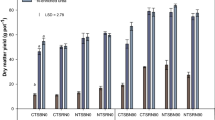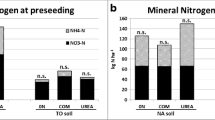Abstract
To investigate the effect of inorganic fertilizer and composted manure amendments on the N isotope composition (delta 15N) of crop and soil, maize (Zea mays L.) was cultivated under greenhouse conditions for 30, 40, 50, 60, and 70 days. Composted pig manure (delta 15N= +13.9‰) and urea (-2.3‰) were applied at 0 and 0 kg N ha−1 (C0U0), 0 and 150 kg N ha−1 (C0U2), 150 and 0 kg N ha−1 (C2U0), and 75 and 75 kg N ha−1 (C1U1), respectively. The delta 15N of total soil-N was not affected by both amendments, but delta 15N of NH+ 4 and NO− 3 provided some information on the N isotope fractionation in soil. During the early growth stage, significant differences (P < 0.05) in delta 15N among maize subjected to different treatments were observed. After 30 days of growth, the delta 15N values of maize were +6.6‰ for C0U0, +1.1‰ for C0U2, +7.7‰ for C2U0, and +4.5‰ for C1U1. However, effects of urea and composted manure application on maize delta 15N progressively decreased with increasing growth period, probably due to isotope fractionation accompanying N losses and increased uptake of soil-derived N by maize. After 70 days of growth, delta 15N of leaves and grains of maize amended with composted pig manure were significantly (P < 0.05) higher than those with urea. The temporal variations in delta 15N of maize amended with urea and composted manure indicate that plant delta 15N is generally not a good tracer for N sources applied to field. Our data can be used in validation of delta 15N fractionation models in relation to N source inputs.
Similar content being viewed by others
References
Beauchamp E G 1986 Availability of nitrogen from three manures to maize in the field. Can. J. Soil Sci. 66, 713-720.
Bergersen F J, Peoples M B and Turner G L 1988 Isotopic discriminations during the accumulation of nitrogen by soybeans. Aus. J. Plant Physiol. 15, 407-420.
Beven K and Germann P 1982 Macropores and water flow in soils. Water Resour. Res. 18, 1311-1325.
Blackmer A S and Bremner J M 1977 Nitrogen isotope discrimination in denitrification of nitrate in soil. Soil Biol. Biochem. 9, 73-77.
Bloom A J 1988 Ammonium and nitrate as nitrogen sources for plant growth. ISI Altas of Sci. 1, 55-59.
Bremer E, Gehlen H, Swerhone G D W and van Kessel C 1993 Assessment of reference crops for the quantification of N2 fixation using natural and enriched levels of 15N abundance. Soil Biol. Biochem. 25, 1197-1202.
Cheng H H, Bremner J M and Edwards A P 1964 Variations in nitrogen-15 abundance in soils. Science 146, 1574-1575.
Chien S H, Shearer G and Kohl D H 1977 The nitrogen isotope effect associated with nitrate and nitrite loss from waterlogged soils. Soil Sci. Soc. Am. J. 41, 63-69.
Choi H L, Richard T L and Kim H T 1996 Composting high moisture materials: Bio-drying poultry manure in a sequentially fed reactor. Korean J. Anim. Sci. 38, 649-658.
Choi W J, Jin S A, Lee S M, Ro H M and Yoo S H 2001 Corn uptake and microbial immobilization of 15N-labeled urea-N in soil as affected by composted pig manure. Plant Soil 235, 1-9.
Delwiche C C and Steyn P L 1970 Nitrogen isotope fractionation in soils and microbial reactions. Environ. Sci. Technol. 4, 929-935.
Ehleringer J R and Rundel P W 1988 Stable isotopes: history, units, and instrumentation. In Stable Isotopes in Ecological Research. Eds. P W Rundel et al., pp. 1-15 Springer-Verlag, New York.
Eshetu Z and Högberg P 2000 Effects of land use on 15N natural abundance of soils in Ethiopian highlands. Plant Soil 222, 109-117.
Evans R D 2001 Physiological mechanisms influencing plant nitrogen isotope composition. Trends Plant Sci. 6, 121-126.
Evans R D, Bloom A J, Sukrapanna S S and Ehleringer J R 1996 Nitrogen isotope composition of tomato (Lycopersicon esculentum Mill. Cv. T-5) grown under ammonium or nitrate nutrition. Plant Cell Environ. 19, 1317-1323.
Feast N A and Dennis P F 1996 A comparison of methods for nitrogen isotope analysis of groundwater. Chem. Geol. 129, 167-171.
Fenn L B and Miyamoto S 1981 Ammonia loss and associated reactions of urea in calcareous soils. Soil Sci. Soc. Am. J. 45, 537-540.
Feigin A, Shearer G, Kohl D H and Commoner B 1974 The amount and nitrogen-iS content of nitrate in soil profiles from two central Illinois fields in a con-soybean rotation. Soil Sci. Soc. Am. Proc. 38, 465-471.
Firestone M K 1982 Biological denitrification. In Nitrogen in Agricultural Soils, Agronomy No. 22. Ed. F J Stevenson. pp. 289-326. ASA, Wisconsin.
Handley L L and Raven J A 1992 The use of natural abundance of nitrogen isotopes in plant physiology and ecology. Plant Cell Environ. 15, 965-985.
Handley L L and Scrimgeour C M 1996 Terrestrial plant ecology and 15N natural abundance: The present limits to interpretation for uncultivated systems with original data from a Scottish old field. Adv. Ecol. Res. 27, 133-212.
Hauck R D 1982 Nitrogen-isotope ratio analysis. In Methods of Soil Analysis. Part 2: Chemical and Micorbiological Properties. Eds. A L Page et al. pp 735-779. ASA and SSSA, Madison and Wisconsin.
Heaton T H E 1986 Isotopic studies of nitrogen pollution in the hydrosphere and atmosphere: a review. Chem. Geol. (Isotope Geoscience Section) 59, 87-102.
Hodges R D 1991 Soil organic matter: Its central position in organic farming. In Advances in Soil Organic Matter Research: The Impact on Agriculture and The Environment. Ed. W S Wilson. pp 355-364. The Royal Society of Chemistry, Redwood Press, Wiltshire.
Högberg P 1997 Tansley Review No.95 15N natural abundance in soil-plant systems. New Phytol. 137, 179-203.
Högberg P and Johannison C 1993 15N abundance of forests is correlated with losses of nitrogen. Plant Soil 157, 147-150.
Karamanos R E and Rennie D A 1981 The isotope composition of residual fertilizer nitrogen in soil columns. Soil. Sci. Soc. Am. J. 45, 316-321.
Keeney and Nelson 1982 Nitrogen-inorganic forms. In Methods of Soil Analysis. Part 2: Chemical and Micorbiological Properties. Eds. A L Page et al. pp. 643-698. ASA and SSSA, Madison and Wisconsin.
Kerley S J and Jarvis S C 1996 Preliminary studies of the impact of excreted N on cycling and uptake of N in pasture systems using natural abundance stable isotope discrimination. Plant Soil 178, 287-294.
Klauer S F, Franceschi V R and Ku M S B 1991 Protein composition of mesophyll and paraveinal mesophyll of soybean leaves at various developmental stages. Plant Physiol. 97, 1306-1316.
Kohl D H and Shearer G 1980 Isotopic fractionation associated with symbiotic N2 fixation and uptake of NO -3 by plants. Plant Physiol. 66, 51-56.
Kohl D H, Shearer G and Commoner B 1973 Variation in 15N in maize and soil following application of fertilizer nitrogen. Soil Sci. Soc. Am. Proc. 37, 888-892.
Kuzyakov Y, Friedel J K and Stalir K 2000 Review of mechanisms and quantification of priming effects. Soil Biol. Biochem. 32, 1485-1498.
Limaux F, Recous S, Meynard J M and Guckert A 1999 Relationship between rate of crop growth at date of fertilizer N application and fate of fertilizer N applied to winter wheat. Plant Soil 214, 49-59.
Mariotti A, Germon J C, Huber P, Kaiser P, Letolle R, Tardieux A and Tardieux P 1981 Experimental determination of nitrogen kinetic isotope fractionation: some principles; illustration for the denitrification and nitrification processes. Plant Soil 62, 423-430.
Mariotti A, Mariotti F, Champigny M L, Amarger N and Moyse A 1982 Nitrogen isotope fractionation associated with nitrate reductase activity and uptake of NO -3 by Pearl Millet. Plant Physiol. 69, 882-884.
Millard P 1988 The accumulation and storage of nitrogen by herbaceous plants. Plant Cell Environ. 11, 1-8.
Monaghan R and Barraclough D 1995 Contributions to gross N mineralization from 15N-labelled soil macroorganic matter fractions during laboratory incubation. Soil Biol. Biochent 27, 1623-1628.
Nadelhoffer K J and Fry B 1994 Nitrogen isotope studies in forest ecosystems. In Stable Isotope in Ecology and Environmental Sciences. Eds. K Lajtha and R H Michener. pp. 23-44. Blackwell, MA.
Nadelhoffer K J, Shaver G, Fry B, Giblin A, Johnson L and McKane R 1996 15N natural abundance and N use by tundra plants. Oecologia 107, 386-394.
Papendick R I and Elliott L F 1984 Tillage and cropping systems for erosion control and efficient nutrient utilization. In Organic Farming: Current Technology and its Role in a Sustainable Agriculture. ASA Spec. Publ. 46. Eds. D F Bezdicek et al. pp. 69-81. ASA, CSSA and SSSA, Wisconsin.
Paul J W and Beauchamp E G 1993 Nitrogen availability for maize in soils amended with urea, cattle slurry, and solid and composted manures. Can. J. Soil Sci. 73, 253-266.
Recous S, Fresneau C, Faurie G and Mary B 1988 The fate of labeled 15N urea and ammonium nitrate applied to a winter wheat crop: 1. Nitrogen transformations in the soil. Plant Soil 112, 205-214.
Robinson D 2001 ?15N as an integrator of the nitrogen cycle. Trends Ecol. Evol. 16, 153-162.
Robinson D, Handley L L and Scrimgeour C M 1998 A theory for 15N/14N fractionation in nitrate-grown vascular plants. Planta 205, 397-406.
SAS Institute 1989 SAS/STAT user's guide. Version 6. 4th edn. Vol 2. SAS Inst., North Carolina.
Shearer G and Kohl D H 1986 N2-fixation in field settings: Estimations based on natural 15N abundance. Aus. J. Plant Physiol. 13, 699-756.
Shearer G, Kohl D H and Chien S H 1978 The nitrogen-iS abundance in a wide variety of soils. Soil Sci. Soc. Am. J. 42, 899-902.
Shearer G and Legg J O 1975 Variations in the natural abundance of 15N of wheat plants in relation to fertilizer nitrogen applications. Soil Sci. Soc. Am. Proc. 39, 896-901.
Shipitalo M J, Edwards W M, Dick W A and Owens L B 1990 Initial storm effects on macropore transport of surface-applied chemicals in no-till soil. Soil Sci. Soc. Am. J. 54, 1530-1536.
Ta C T 1991 Nitrogen metabolism in the stalk tissue of maize. Plant Physiol. 97, 1375-1380.
Turner G L, Bergersen F J and Tantala H 1983 Natural enrichment of 15N during decomposition of plant material in soil. Soil Biol. Biochem. 15, 495-497.
Turner G L, Gault R R, Morthorpe L, Chase D L and Bergersen F J 1987 Differences in the natural abundance of 15N in the extractable mineral nitrogen of cropped and fallowed surface soils. Aus. J. Agric. Res. 38, 15-25.
van Dam D and van Breemen N 1995 NICCE: a model for cycling of nitrogen and carbon isotopes in coniferous forest ecosystems. Ecol. Model. 79, 255-275.
van Kessel C, Pennock D J and Farrell R E 1993 Seasonal variations in denitrification and nitrous oxide evolution at the landscape scale. Soil Sci. Soc. Am. J. 57, 988-995.
Weitz A M, Linder F, Frolking 5, Crill P M and Keller M 2001 N20 emissions from humid tropical agricultural soils: effects of soil moisture, texture and nitrogen availability. Soil Biol. Biochem. 33, 1077-1093.
Wen G, Bates T E and Voroney R P 1995. Evaluation of nitrogen availability in irradiated sewage sludge, sludge compost, and manure compost. J. Environ. Qual. 24, 527-534.
Yoneyama T and Kaneko A 1989 Variations in the natural abundance of 15N in nitrogenous fractions of komatsuna plants supplied with nitrate. Plant Cell Physiol. 30, 957-962.
Yoneyama T, Kouno K and Yazaki J 1990 Variation of natural 15NN abundance of crops and soils in Japan with special reference to the effect of soil conditions and fertilizer application. Soil Sci. Plant Nutr. 36, 667-675.
Yoneyama T, Omata T, Nakata S and Yazaki J 1991 Fractionation of nitrogen isotopes during the uptake and assimilation of ammonia by plants. Plant Cell Environ. 32, 1211-1217.
Author information
Authors and Affiliations
Corresponding author
Rights and permissions
About this article
Cite this article
Choi, WJ., Lee, SM., Ro, HM. et al. Natural 15N abundances of maize and soil amended with urea and composted pig manure. Plant and Soil 245, 223–232 (2002). https://doi.org/10.1023/A:1020475017254
Issue Date:
DOI: https://doi.org/10.1023/A:1020475017254




